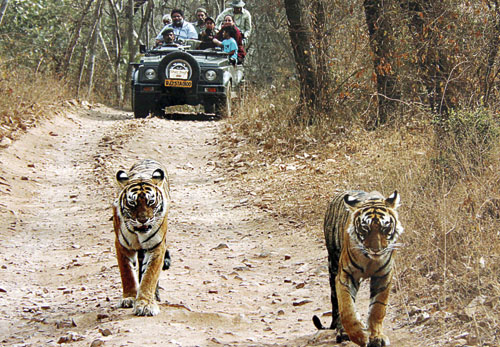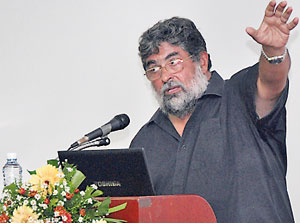Animation, admiration and passion blend together as he talks not only of their uniqueness but also their idiosyncrasies, as a father would lovingly talk of his sons and daughters.‘Genghis’ would race with rippling muscles into a lake, grab a sambhur watering there, dunk it and then kill it, says this ‘tiger man’ of India, Valmik Thapar, describing the “unique behaviour” of this great hunter which he had watched and admired oft times.
A foremost name in tiger conservation, Valmik was in Sri Lanka last week for the first time, in-between the researching and writing of books, to give a talk on ‘Tigers in the wild’ and make a quick tour of Colombo and Galle with his family. Yala where there are many exotic animals including the leopard would be on his itinerary next time he, wife Sanjna Kapoor and son Hamir visit Sri Lanka, he has promised himself, while taking a packed house at the Bandaranaike Centre for International Studies on the trail of the tiger during the talk-cum-slide show organised by the Indian Cultural Centre, Colombo, in association with the BCIS and Ruk Rakaganno.
 |
| Pictures from ‘The Tiger: Soul of India’ published by
the Oxford University Press |
For Valmik, natural historian and wildlife documentary film-maker, the love affair with this majestic Big Cat began way back in 1976. “Totally enchanted,” he became 36 years ago, in March 1976, when he was on a 15-day trip to Ranthambore National Park with Director Fateh Singh, and had an encounter with a tigress and her cubs.
The first glimpse engraved in his memory, however, is as a nine-year-old precariously atop an elephant at Corbett National Park in Uttar Pradesh, along with an uncle, of a tigress with two cubs snarling up at the elephant.
It was after Valmik’s visit to the magical plains of Ranthambore in Rajasthan -- spread over 1,000 sq km dotted with ancient ruins including a fort and “full of memories of India” -- that he kept going back and researching the tiger. Where else amidst the ancient walls in the middle of the night in the beam of the jeep lights would you see “a tiger pop its head out”. So enthralled was he that the jeep ended up in the lake nearby.
Incidentally, Ranthambore was the former hunting grounds of the Maharajas of Jaipur, but now according to Valmik this is where the tiger “performs” in its natural habitat, enticing many a visitor including former American President Bill Clinton after whose visit the park was put on the map. “If not for that sort of prominence, Ranthambore would have been bulldozed and made into a concrete jungle.”
His answer to the query, “Why the tiger?” is simple.
He felt they were the greatest challenge and wanted to learn about them and the different facets of their life in their natural habitat. After he fell in love with the tiger, as he succinctly states in his book, ‘The Tiger: Soul of India’ published by the Oxford University Press last year, “…….this love survived the vagaries of time and the vision of the tiger continues to haunt me in the most enthralling way……To me it, in fact, personifies pleasure, thrill, excitement, wonder, energy, power, fear, respect, love and absolute beauty rolled into one – what else can one want from life!”
The 1980s and 1990s, Valmik considered a walking encyclopaedia on the tiger, spent visually describing this somewhat unknown quantity and enjoying every moment as well. He was not on a mission to “capture” tigers on camera, but with the camera dangling round his neck it was only natural for him to photograph them.
This was the work which was picked up as documentaries by the British Broadcasting Corporation (BBC), Animal Planet, Discovery and National Geographic.
Among his many books are ‘Tigers – My Life’, ‘Ranthambhore: 10 Days in the Tiger Fortress’, ‘The Secret Life of the Tiger’ and ‘The Last Tiger: Struggling for Survival’, all documenting “every nuance of the tiger” that he has pursued including their behaviour, sociology, mating patterns, family life et al.
Having given us a snapshot of Genghis, named after the mighty warrior king Genghis Khan, Valmik picks out two more of his favourites.....‘Noon’ who strode Ranthambore haughtily, charging the deer in the middle of the day although tigers are nocturnal creatures and acquiring her name by that, and ‘Machli’ whom he believes is either her niece or grand-niece.
“Noon was the star of Ranthambore,” smiles Valmik, explaining that it was she who was seen by Rajiv Gandhi when he visited the park in 1986 while he was Prime Minister.
Machli brought her cubs into public view, having litters every two years for about 10 years, he says, now an expert in identifying tigers through their facial and body stripes. Having seen probably 200 tigers, he has put most of them into his book, ‘Tigers of the Emerald Forest’ which will be hot off the presses of the Oxford University Press in February.
His love of the tiger also prompted him to travel to Africa, from which sojourns came two books on his experiences there. “The tiger walks on the richest part of India where there is valuable timber and a wealth of mines,” and Valmik fears for it and believes it is dying, treading the same path as the lions of India. Officials give a figure of 1,500 but he believes that there are only about 1,200 tigers left in India.
Poring over nearly 300 books, even while on holiday in the Maldives and Sri Lanka, Valmik is now nurturing the seed of an idea for a book on 500 years of tiger encounters from the time of the Moghuls, through the colonial era onto the modern day and what people have observed before they hunted and killed the tiger.
Sharing his love of the tiger with his son, both of whom he dubs a “delight” he is happy that his actress wife who is an underwater-life aficionado (“she was scuba diving in the Maldives photographing manta rays,” he says) is also very much a part of the safaris. His son has, in fact, written a 120-page first-book on ‘My Kenyan Safari’.
As he turns 60 in September, Valmick’s wish for the tigers of India is that “we will find new ways to defend and protect them”. Otherwise, we may be hearing the last growls of the tiger, for they will be here today and gone tomorrow, he sighs.
Conservation: Valmik on war path
Take a lesson out of the book of Africa, urges wildlife crusader Valmik Thapar not only to India but also countries like Sri Lanka.
Having plunged into the politics of tiger conservation by being on nearly 200 government committees in India since 1992, a “great waste of time”, and studying every nuance of the politics of conservation, he lashes out at bureaucrats as lacking intelligence. Currently he is on the National Board of Wildlife chaired by the Prime Minister.
You think you have made some headway after meeting them but realise that it is not so, he says, stressing that the bureaucrats still set the same rules. Valmik who “comes from a family that is political” (his father Romesh and mother Raj are reputed journalists while veteran journalist Karan is his cousin) is fighting furious battles to make bureaucrats “who are the destroyers of everything” do a drastic rethink of policy.
 |
| Valmik at the BCIS.
Pic by Mangala Weerasekera |
Whether we want to protect our wildlife or whether we want to surround ourselves with concrete is a choice that our generation will have to make in the very near future, he points out, underscoring the fact that the thinking should be out of the box and conservation should be less dependent on bureaucrats and more on the local communities. Give the management of the landscape to outside talent such as wildlife researchers and sociology graduates, he urges, taking it away from the government. Integrate all facets, bringing in new ideas and models for conservation.
People think that forest officers will take care of everything, but that’s not the case. We need to take a good look at our forests and learn about it. Our culture has grown around forests, our ancestors revered them. Now everybody wants to get into the green groove but only get caught up in the commercialisation with nothing substantial being done in the end. The concept of greed has taken over. So it is important to give back to the forest, he says, fighting the politicians tooth and nail to change policy.
African countries such as Kenya, Botswana and Zambia have shown the way, according to Valmik, by channelling 80% of the fees the national parks get from tourism back to the forests and wildlife.
Good, sensible tourism is vital, he says. |




